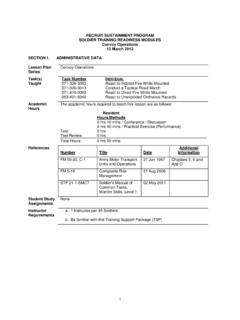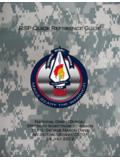Transcription of RECRUIT SUSTAINMENT PROGRAM SOLDIER TRAINING …
1 1 RECRUIT SUSTAINMENT PROGRAM SOLDIER TRAINING READINESS MODULES Detainee Operations Search a Detainee 12 March 2012 SECTION I. ADMINISTRATIVE DATA Lesson Plan Series Detainee Operations Search a Detainee Task(s) Taught Task Number INDIVIDUAL 191-377-4254 Search a Detainee Academic Hours The academic hours required to teach this lesson are as follows: Resident Hours/Methods 0 hrs 50 mins / Conference / Discussion 0 hrs 00 mins / Practical Exercise (Performance) Test 0 hrs Test Review 0 hrs Total Hours: 0 hrs 50 mins References Number Title Date Additional Information FM Military Police Intern- ment/Resettlement Operations 11 Mar 2009 STP 19-31B1-SM, C-1 MOS 31B, Military Police Skill Level 1, Soldiers Manual 05 Dec 2007 STP 21-1-SMCT Soldiers Manual of Common Tasks, SOLDIER Skills, Level 1 02 May 2011 Student Study Assignments None Instructor Requirements a. 1 Instructor per 35 Soldiers b. Be familiar with this TRAINING Support Package (TSP) Equipment Required Id Name Stu Ratio Inst Ratio Spt Qty Exp 5836013927680/96454N LCD DATA PROJECTOR 1:1 No 0 No 6730-00-577-4813 Screen, Projection, BM-10A, Stand 1:1 No 0 No 702102982124/70209N Computer, Personal System 1:1 No 0 No Contraband such as Maps, Paper, plastic knife, ID Card, camera 1:1 No 0 No 2 Materials Required Instructor Materials: a.
2 This TRAINING Support Package (TSP) Student Materials: a. Other materials as directed by RSP Unit SOP Classroom, TRAINING Area, and Range Requirements Organizational Classroom Instructional Guidance NOTE: Before presenting this lesson, instructors must thoroughly prepare by studying this lesson and the identified reference material. Prior to class, arrange for additional cadre (if necessary Students may serve as prisoners) to serve as prisoners. If detainee plastic zip ties or flexi cuffs are not available, use or simulate use of boot strings belonging to the prisoner. Gain permission to allow at least one of the prisoners to carry a weapon (pistol or knife). There are a number of knots that may used to detain a prisoner. If time allows, consult with the Military Police. They will be able show you several methods. 3 SECTION II. INTRODUCTION NOTE: SHOW Slide 1 (STRM) Method of Instruction: Conference / Discussion Instructor to Student Ratio is: 1:35 Time of Instruction: 5 mins Media: Slide Presentation Motivator All Soldiers participating in military operations must be prepared to process detainees.
3 Your actions at which you have custody of and are responsible for safeguarding a detained person can directly affect the success of your mission and could even have a lasting impact on strategic military objectives. Terminal Learning Objective NOTE: SHOW Slide 2 (Terminal Learning Objective) NOTE: Inform the students of the following Terminal Learning Objective requirements. At the completion of this lesson, you [the student] will: Action: Search a Detainee Conditions: Given a classroom or field environment, Rules of Engagement (ROE) or Rules for the Use of Force (RUF) and a guard to assist with the search Standards: Search a Detainee, locate and confiscate all items, maintain accountability and control Safety Requirements Conduct a safety brief prior to TRAINING as needed and IAW unit and installation policies. Risk Assessment Level Low - Risk Assessment to be produced locally IAW FM 5-19, August 2006. Evaluation None Instructional Lead-In Detaining and processing a prisoner might seem a distant possibility, however think of the following possibilities.
4 Many of you may remember Desert Shield/Storm in 1991when Iraqi Soldiers surrendered by the hundreds, or more recently as Saddam Hussein s Royal Guard turned themselves in by the battalion. Many states have Army National Guard teams that work the Drug Enforcement Agency for surveillance, and in many cases arrest those involved in growing or the manufacture of illegal substances. Or, the Army National Guard may be ordered by the Governor of their State to guard and arrest criminals taking advantage of a natural disaster with any number of crimes. 4 SECTION III. PRESENTATION 1. Learning Step / Activity 1. Search a Detainee Method of Instruction: Conference / Discussion Instructor to Student Ratio: 1:35 Time of Instruction: 40mins Media: Slide Presentation a. Detainees pose significant operational risks that can hinder mission success in numerous ways. The Army Values have been instilled in you and you should ensure you practice those values when accomplishing the task of searching a detainee.
5 NOTE: SHOW Slide 3 (Detainee Operations) NOTE: The following talking points support the bullet points on the slides; however it is always best to introduce personal experiences or examples to further define and offer the contemporary environment. b. Detainee Operations. (1) Most detainees are captured during a combat engagement and will most likely have weapons with unused ammunition and explosives. You must disarm and secure them to ensure that no further harm can be inflicted either to you or them. Hostile detainees will require greater control measures which may become resource intensive. (2) Upon capturing detainees, you must monitor and control your emotions. It is certainly possible that that detainee had just been shooting at you or may have killed or wounded a fellow SOLDIER . Amidst this level of tension, you must rely on our Army Values; you must strictly adhere to military policy and the published Rules of Engagement (ROE), and the Rules of Use of Force (RUF).
6 Under no circumstances, can you allow yourself or others to retaliate, or otherwise allow harm to befall detainees under your control. (3) forces may capture from one to dozens or more detainees. In fact, some operations such as Cordon and Searches can lead to the capture of over a hundred detainees at a single point. While one or two detainees may not create a significant challenge, more detainees will require more Soldiers and resources. Large numbers of detainees pose greater security risks to you and as well as risks to each other. You must safeguard detainees to include providing adequate space, food, and waste disposal, as appropriate. Added to your primary task of guarding detainees, these tasks may require more security, additional transport, cause significant delays for onward movement, and divert unit assets from their primary mission. (4) Wounded or injured detainees may require special medical attention that could delay movement, deplete your resources, and could complicate other detainee operational tasks such as security and segregation.
7 C. The point of capture (POC). This represents the most vulnerable point at which Soldiers will process detainees. It often requires Soldiers to disarm, search, and guard detainees in an unsecured environment among other potential combatants or sympathizers. Small units at the point of capture will probably not have enough resources and manpower to provide for a large number of detainees, but still must begin processing detainees while waiting for the arrival of additional resources and transportation. Here, leaders and Soldiers may have to assess the risks between 5 providing security against potential attack from other combatants or sympathizers in the area, and providing enough security to control their detainees. (1) The POC is where most of detainee abuse allegations occur; it is the point where emotions following enemy contact may run high and where a need for immediate intelligence may prevent additional casualties. Leaders and Soldiers must maintain situational understanding and monitor unit and individual stress to reduce the potential for further escalation and prevent violations of military policy.
8 (2) The POC is the first decision point at which forces will determine whether a detainee is to be retained or released. NOTE: SHOW Slide 4 ( 5 S s & T Technique) d. Soldiers must process detainees using the 5 S s and T technique: Search, Silence, Segregate, Safeguard, Speed to a Safe Area, and Tag. These procedures provide a structure to guide you in conducting detainee operations until you transfer custody of detainees to another authority or location. (1) Search. Includes those actions taken to neutralize a detainee and confiscate weapons, personal items, and items of potential intelligence/evidentiary value. (2) Silence. Prevent detainees from communicating with one another or from making audible clamor such as chanting, singing, praying, etc. Silence uncooperative detainees by muffling them using a soft clean cloth tied around their mouth and fastened at the back of the head. DO NOT use duct tape or other adhesives, place cloth or objects inside the mouth, or apply physical force to silence detainees.
9 (3) Segregate. Segregate detainees IAW policy and SOPs; segregation requirements will differ from operation to operation. Your ability to segregate detainees may also be limited at the point of capture by your available manpower and resources. At a minimum, strive to segregate by rank, gender, adults from juveniles (keep mothers with small children), and based on security risk. Military Intelligence (MI) and Military Police (MP) can provide additional guidance and support in determining appropriate segregation criteria. (4) Safeguard. Refers to your obligation to protect detainees safety and ensure the custody and integrity of all confiscated items. You must safeguard detainees from continuing combat risk, from harm caused by other detainees, and from improper treatment or care. Report all injuries. Correct and report violations of military policy that occur while safeguarding detainees. Acts and or omissions that constitute inhumane treatment are violations of the law of armed conflict, and as such must be corrected immediately.
10 Simply reporting violations is insufficient. If a violation is ongoing, a SOLDIER has an obligation to stop the violation as well as report it. (5) Speed to Safe Area. Quickly move detainees from the continuing risks associated with other combatants or sympathizers who may still be in the area of capture. If you have more detainees than you can control, call for additional support, search, and hold in place until reinforcements arrive. NOTE: SHOW Slide 5 (Accountable for Detainee and Property) NOTE: Handout Student Handouts 1 & 2. (6) Tag. Ensure each detainee is tagged using an authorized Capture Tag (DD Form 2745), which provides the only official detainee tracking number prior to 6 receiving an Internment Serial Number. All confiscated equipment, personal items, and evidence will be linked to the detainee using the Capture Tag Serial Number. When an Evidence/Property Custody Document (DA Form 4137) is used to document confiscated items, it will be linked to the detainee by annotating the Capture Tag Serial Number on the form.



